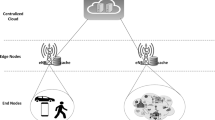Abstract
This paper presents an adaptive location management strategy that considers both location updating and paging by evaluating realistic mobility patterns. It proposes the design of an adaptive macro-location area based on multi-registration adapted to the terminals’ trajectory to reduce location updates. The solution includes an estimation of residence probabilities in the areas of the multi-registered list. This facilitates the design of a sequential paging scheme that reduces the average paging cost. Results show the capability of the solution to adapt to mobility patterns and traffic conditions in the network to minimize the overall location cost. Furthermore, the multi-registration approach and the reduced complexity in both network infrastructure and mobile terminals make the solution suitable for new packet-based broadband cellular systems.
Similar content being viewed by others
References
Feng, L., Zhao, Q., & Zhang, H. (2007). Location management based on distance and direction for PCS networks. Computer Networks, 51(1), 134–152.
Abutaleb, A., & Li, V. O. K. (1997). Location update optimization in personal communication systems. Wireless Networks, 3(3), 205–216.
Rose, C. (1996). Minimizing the average cost of paging and registration: a timer-based method. Wireless Networks, 2, 629–638.
Hwang, H.-W., Chang, M.-F., & Tseng, C.-C. (2000). A direction-based location update scheme with a line-paging strategy for PCS networks. IEEE Communications Letters, 4, 149–151.
Akyildiz, I. F., Ho, J. S. M., & Lin, Y.-B. (1996). Movement-based location update and selective paging for PCS networks. IEEE/ACM Transactions on Networking, 4(4), 629–638.
Bar-Noy, A., Kessler, I., & Sidi, M. (1995). Mobile users: to update or not to update? Wireless Networks, 1, 175–195.
Kyamakya, K., & Jobmann, K. (2005). Location management in cellular networks: classification of the most important paradigms, realistic simulation framework, and relative performance analysis. IEEE Transactions on Vehicular Technology, 54(2), 687–708.
Brown, T. X., & Mohan, S. (1997). Mobility management for personal communication systems. IEEE Transactions on Vehicular Technology, 46(2), 269–278.
Birk, Y., & Nachman, Y. (1995). Using direction and elapsed-time information to reduce the wireless cost of locating mobile units in cellular networks. Wireless Networks, 1(4), 403–412.
Lee, B.-K., & Hwang, C.-S. (1999). A predictive paging scheme based on the movement direction of a mobile host. In Proc. IEEE VTC’99 (pp. 2158–2162).
Rose, C., & Yates, R. (1995). Minimizing the average cost of paging under delay constraints. Wireless Networks, 1(2), 211–219.
Krishnamachari, B., Gau, R.-H., Wicker, S. B., & Haas, Z. (2004). Optimal sequential paging in cellular wireless networks. Wireless Networks, 10(2), 121–131.
Abutaleb, A., & Li, V. O. K. (1997). Paging strategy optimization in personal communication systems. Wireless Networks, 3(3), 195–204.
3GPP TS 23.401. (2009-03). Technical specification group services and system aspects; general packet radio service (GPRS) enhancements for evolved universal terrestrial radio access network (E-UTRAN) access (Release 9) V9.0.0.
James, T., Vroblefski, M., & Nottingham, Q. (2007). A hybrid grouping genetic algorithm for the registration area planning problem. Computer Communications, 30(10), 2180–2190.
Wang, T.-P., Hwang, S.-Y., & Tseng, C.-C. (1998). Registration area planning for PCS networks using genetic algorithms. IEEE Transactions on Vehicular Technology, 47(3), 987–995.
Vroblefski, M., & Brown, E. C. (2006). A grouping genetic algorithm for registration area planning. Omega, 34, 220–230.
Bhattacharjee, P. S., Saha, D., & Mukherjee, A. (2004). An approach for location area planning in a personal communication services network (PCSN). IEEE Transactions on Wireless Communications, 3, 1176–1187.
Shyu, S., Lin, B. M. T., & Hsiao, T. (2006). Ant colony optimization for the cell assignment problem in PCS networks. Computers & Operations Research, 33(6), 1713–1740.
Bejerano, Y., Smith, M. A., Naor, J., & Immorlica, N. (2006). Efficient location area planning for personal communication systems. IEEE/ACCM Transactions on Networking, 14(2), 438–450.
Kunz, T., Siddiqi, A. A., & Scourias, J. (2001). The Peril of evaluating location management proposals through simulations. Wireless Networks, 7(6), 635–643.
García, P., Casares, V., & Mataix, J. (2002). Reducing location update and paging costs in a PCS network. IEEE Transactions on Wireless Communications, 1(1), 200–209.
Wong, V. W.-S., & Leung, V. C. M. (2000). Location management for next-generation personal communication networks. IEEE Network, 14(4), 18–24.
Kazantzakis, M. G., Koukoutsidis, I. Z., Demestichas, P. P., & Theologou, M. E. (2004). Probability criterion paging area planning in future mobile communications systems. Computer Communications, 27(7), 581–588.
Pattaramalai, S., & Aalo, V. A. (2008). Distribution of random sum cell dwell times in wireless network. IEE Electronics Letters, 44(4), 301–302.
Scourias, J., & Kunz, T. (1999). Activity-based mobility modeling: realistic evaluation of location management schemes for cellular networks. In Proc. IEEE WCNC’99, Vol. 1, New Orleans, USA (pp. 296–300).
Bratanov, P. I., & Bonek, E. (2003). Mobility model of vehicle-borne terminals in urban cellular systems. IEEE Transactions on Vehicular Technology, 52(4), 947–952.
Fiore, M., Härri, J., Fethi, F., & Bonnet, C. (2007). Vehicular mobility simulation for VANETs. In Proc. of the 40th IEEE annual simulation symposium (ANSS’07), Mar. 2007, Norfolk, USA.
Härri, J., Fiore, M., Fethi, F., & Bonnet, C. (2006). VanetMobiSim: generating realistic mobility patterns for VANETs. In Proc. of the 3rd ACM international workshop on vehicular ad hoc networks (VANET’06), Sep. 2006, Los Angeles, USA.
Jardosh, A., Belding Royer, E. M., Almeroth, K. C., & Suri, S. (2003). Towards realistic mobility models for mobile ad hoc networks. In Proc. of the 9th annual international conference on mobile computing and networking (MOBICOM’03), San Diego, USA (pp. 217–219).
Author information
Authors and Affiliations
Corresponding author
Rights and permissions
About this article
Cite this article
Canales, M., Gállego, J.R., Hernández, Á. et al. An adaptive location management scheme for mobile broadband cellular systems. Telecommun Syst 52, 299–315 (2013). https://doi.org/10.1007/s11235-011-9665-3
Published:
Issue Date:
DOI: https://doi.org/10.1007/s11235-011-9665-3




